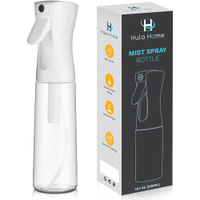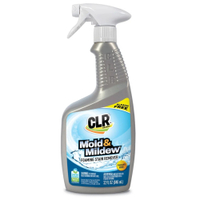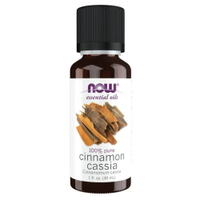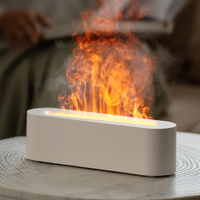How to get rid of mold in a basement, according to experts
'Getting rid of mold in the basement involves addressing moisture issues, improving ventilation, cleaning and drying affected areas, and being vigilant about future mold growth'


Mold thrives in dark, damp, humid environments, making basements one of the main spaces in any home that it is likely to grow in. Mold can be harmful and difficult to get rid of, so it is important to make sure you know how to get rid of mold in your basement as soon as you find it.
Mold can grow discreetly in your basement, so if you suspect you have an infestation, check behind your furniture, walls, vents, under carpets and basement floors to identify any mold that needs to be tackled and plan the measures to take.
To effectively tackle mold in your basement, it's crucial to implement a range of approaches that combine cleaning, moisture control, and preventive measures. These seven steps from experts can help you to remove and prevent mold in your basement, ensuring your home remains safe.
How to get rid of mold in a basement
Eliminating mold in a basement demands a methodical strategy to ensure the effective removal of existing mold as well as preventing its recurrence.
1. Identify the source

'The first step in tackling mold is identifying and addressing the source of moisture that is fostering mold growth,' says Josh Mitchell, plumbing expert and the owner of Plumbing Lab. 'This could be leaks in basement ceilings, walls, floors, plumbing fixtures, or inadequate ventilation.
'Fixing these issues is crucial to prevent mold from returning.'

Josh Mitchell is, a plumbing expert and HVAC technician and the owner of Air Conditioner Lab and Plumbing Lab
2. Fix any sources of water leakage

Repair any leaks and seal cracks in the basement walls, windows, floors, or foundations. To do this you can use waterproof caulk or strips, such as this leakproof seal strip, or this waterproof silicone caulk sealant, from Amazon.
You can also apply waterproof paint or coatings as an additional barrier against moisture.
'Older pipes are more prone to leaks and may need to be replaced,' recommends Mark Brunke, general manager of Environmental Plumbing.
'Additionally, if condensation is gathering on pipes, this can be an indication that your pipes aren't properly insulated. Insulate those pipes to reduce condensation and subsequent moisture content in the basement.' You can use this pipe insulation foam, from Amazon.
Finally, you should waterproof a basement by ensuring proper drainage around the foundation to eliminate water seepage issues.
3. Clean away any mold

'For small mold patches, a DIY approach can be effective, but avoid using bleach as it doesn't prevent mold from returning,' explains Michael Golubev, CEO of Mold Busters.
'When cleaning mold, wear protective gear like gloves, goggles, and a mask. Ensure good ventilation to avoid inhaling mold spores.'
Apply your chosen cleaning solution to the infected surfaces, letting it sit for the recommended time. Then wipe it using paper towels, and repeat the process several times. Finally, dry the area to reduce the risks of further infestation by mold.
'Choose eco-friendly cleaning products that efficiently eradicate mold without using harsh chemicals,' advises Abner Miller, certified mold inspector of Starlinkhow. 'Natural substitutes such as baking soda, hydrogen peroxide, vinegar, or tea tree oil can effectively fight against the mold.'
Baking soda can not only kill mold but also remove moisture, preventing the development of mold. To use this method, use a quarter of a teaspoon mixed with water in a spray bottle. Mist the affected areas, then use a sponge to remove any remaining mold before giving the area a thorough rinse with water. Let the surface dry fully.
You can apply 3% hydrogen peroxide in a spray bottle to the moldy area. After letting this sit for 10 minutes, use a moist towel or cloth to wipe away any mold.
Alternatively, you can use vinegar with a mold-killer in a spray bottle, especially when removing mold from wood. This can be diluted with water and essential oils to lessen the odor. Make sure the essential oil will not damage the surface you are using this spray on. Let this solution sit on the affected area for a few hours. Then, gently scrape off any mold with a brush.
Using essential oils, such as thyme, tea tree, clove oil, or cinnamon to prevent mold is another eco-friendly method. These organic substances can prevent mold from returning. Simply add your chosen essential oils to a spray bottle with water, with the ratio of one teaspoon of oil to one cup of water, applying the solution to infected areas and leaving it for an hour. Then wipe it away it a towel or cloth.
After cleaning, ensure the area is well-ventilated to dry out completely. Use fans or dehumidifiers to help in drying.
Hula Home Continuous Spray Bottle | Was $14.99, now $7.99 at Amazon
CLR Mold & Mildew Foaming Stain Remover Spray | $5.76 at Walmart
Cinnamon Cassia Oil | Was $9.95, now $8.28 at Amazon
4. Remove moldy materials

For persistent mold problems, it may be necessary to remove and replace materials that have been heavily infested.
'Moldy drywall, insulation, or carpeting should be removed and replaced,' advises Josh Mitchell. 'Wear protective gear like gloves and masks to avoid inhaling mold spores during the removal process.'
5. Improve basement air quality

By improving basement airflow by installing exhaust fans, dehumidifiers, or opening windows, and maintaining ideal humidity levels, you can prevent moisture build-up leading to the development of mold that can create an inhospitable environment for it to grow.
'Mold often shows up in basements because of too much humidity or moisture,' explains Josh Mitchell, HVAC expert. 'Your home's HVAC system can play a role in this. If your basement is connected to your heating and cooling system, it's important to make sure your HVAC is set up and maintained correctly. If not, it can create a damp environment where mold thrives.
'Keeping the humidity in your basement between 30% and 50% is crucial. You can use a tool called a hygrometer to check the humidity. If it's too high, your HVAC system might be part of the problem. You can adjust your air conditioner to run more often to reduce humidity.
'Using a dehumidifier along with your HVAC can also help.' Strategically place your dehumidifier for optimal effectiveness.
'Good airflow is also essential,' continues Josh Mitchell. 'Make sure your HVAC system is moving air well in your basement. Check and clean vents and ducts to make sure they're not blocked. Blockages can stop airflow and increase humidity.
'It's important to service your HVAC system regularly. This includes changing filters and cleaning ducts. This helps stop mold spores from spreading around your home. A well-kept system also works better at controlling moisture.'
If you are still concerned about improving the air quality in your basement, Josh Mitchell explains: 'There are special filters called High-Efficiency Particulate Air (HEPA) filters. These can catch mold spores from the air your HVAC system moves, which prevents them from spreading to other parts of your home.' You can find these HEPA filters at Amazon.
Indoor Thermometer Hygrometer Temperature and Humidity Monitor | Was $19.99, now $9.99 at Amazon
6. Prevent future growth

The next step is to implement some preventative measures to your basement to stop mold growing in the future.
One of the simplest ways to do so is by applying a mold-resistant paint or sealer on
surfaces once they are completely dry.
You can also use essential oils in a diffuser to diffuse mold-killing oils into the air to prevent airborne mold spores from spreading.
Additionally, 'Take into account hydroxyl radicals as a means of air cleansing,' recommends Abner Miller. 'Mould spores and mycotoxins can be effectively neutralized by hydroxyl radicals. It is possible to enhance air quality and prevent the growth of mold in the basement by carefully placing devices that produce hydroxyl radicals, such as a hydroxyl generator.
'Most important is incorporating waterproofing techniques. To build a foundation that is resistant to moisture, investigate contemporary waterproofing techniques including exterior sealants and interior drainage systems.'
Finally, you can invest in intelligent moisture monitoring to identify any moisture issues that may lead to the development of mold. 'Make use of moisture detection systems and smart sensors that offer real-time humidity data,' recommends Abner Miller. 'Thanks to technology, homes can now receive real-time notifications and respond quickly to prevent the growth of mold.' You can find this YoLink smart home water leak sensor kit at Amazon.
Fireplace Flame Essential Oil Diffuser | Was $29.99, now $23.99
7. Regular inspections

Conduct routine inspections for signs of water damage or mold. Keep an eye out for any indications of water damage, leaks, or the onset of mold growth.
Early detection allows for prompt intervention and mitigation.
Regularly check gutters and downspouts for debris, ensuring they direct water away from the foundation.
FAQs
When should you call a professional to deal with mold problems?
In cases of extensive or persistent mold problems, or if you suspect you have toxic black mold, it's wise to call in a professional for a comprehensive assessment and effective remediation.
'If the mold covers a large area (more than 10 square feet), it's best to call a professional,' advises Josh Mitchell, owner of Plumbing Lab. 'Large mold infestations can be hazardous to your health and may require specialized equipment and techniques to remove.
'If mold keeps coming back despite your efforts, professional help can identify and solve underlying issues that might not be obvious.
'Getting rid of mold in the basement involves addressing moisture issues, improving ventilation, cleaning and drying affected areas, and being vigilant about future mold growth. If the problem is extensive or persistent, it's wise to consult with a professional for a comprehensive solution.'
Remember that preventing moisture buildup is crucial in deterring mold growth. Fix leaks promptly, keep your basement well ventilated, maintain appropriate humidity levels and ensure your basement is waterproof to prevent mold from returning. Regular maintenance and vigilance can help keep your basement mold-free.
Sign up to the Homes & Gardens newsletter
Design expertise in your inbox – from inspiring decorating ideas and beautiful celebrity homes to practical gardening advice and shopping round-ups.

Lola Houlton is a news writer for Homes & Gardens. She has been writing content for Future PLC for the past six years, in particular Homes & Gardens, Real Homes and GardeningEtc. She writes on a broad range of subjects, including practical household advice, recipe articles, and product reviews, working closely with experts in their fields to cover everything from heating to home organization through to house plants. Lola is a graduate, who completed her degree in Psychology at the University of Sussex. She has also spent some time working at the BBC.
-
 These are the 6 must-have colors to decorate with in April 2025
These are the 6 must-have colors to decorate with in April 2025What do retro-inspired yellows and beautiful blues all have in common? They're on our hot list for the season ahead
By Sophia Pouget de St Victor Published
-
 Plants never to grow next to fruit trees
Plants never to grow next to fruit treesExpert advice on which plants to keep away from fruit trees to encourage a healthy harvest
By Jacky Parker Published




